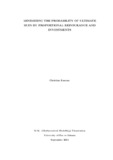Please use this identifier to cite or link to this item:
https://space.mu.ac.zm/xmlui/handle/123456789/146Full metadata record
| DC Field | Value | Language |
|---|---|---|
| dc.contributor.author | Kasumo, Christian | - |
| dc.date.accessioned | 2019-05-27T09:21:15Z | - |
| dc.date.available | 2019-05-27T09:21:15Z | - |
| dc.date.issued | 2011-09 | - |
| dc.identifier.uri | https://space.mu.ac.zm/xmlui/handle/123456789/146 | - |
| dc.description.abstract | The study was conducted on the topic: Minimizing the Probability of Ultimate Ruin by Proportional Reinsurance and Investments. The purpose of the study was to determine the role of investments in minimizing the probability of ultimate ruin of an insurance company, to assess the impact of proportional reinsurance on the survival of insurance companies as well as to determine the optimal reinsurance percentage b ∈ (0,1]. The study considered a risk process comprising a diffusion-perturbated insurance process and a diffusion-perturbated investment generating process in which invest ments were modelled as a Black-Scholes model. The Hamilton-Jacobi-Bellman (HJB) equation for this problem was derived, as well as its corresponding Volterra integro differential equation which was then tranformed into a linear Volterra integral equa tion of the second kind. This integral equation was then solved using the block-by block numerical method for the retention percentage that minimizes the probability of ultimate ruin. The major findings of this study were as follows: 1. That, as expected, the higher the investment rate, the lower the ruin probabil ity. Furthermore, the study has revealed that volatility of stock prices results in higher ruin probabilities. 2. That for a given initial surplus, the ruin probabilities keep reducing as the value of the retention level b reduces. After a certain b, however, the ruin probabilities begin rising again, giving an indication of the location of the optimal retention percentage b∗. 3. That the optimal retention level, given certain assumptions regarding the flow of premium incomes, is b∗ = 0.315034 for the small claim case and b∗ = 0.461538 in the case of large claims. vii Some recommendations have also been made with regard to strategies that could be used by insurance companies to minimize their ultimate ruin probabilities. The study has recommended that in order to minimize their ruin probabilities insurers should invest their surplus in both risky and risk-free assets. It has also been recommended that insurers buy reinsurance as it helps in reducing the probability of ultimate ruin for insurance companies. But, given certain assumptions regarding the flow of premium incomes, insurers can only reinsure optimally when b∗ = 0.315034 for small claims and b∗ = 0.461538 for large ones. | en_US |
| dc.language.iso | en | en_US |
| dc.publisher | University of Dar es Salaam | en_US |
| dc.subject | Probability, proportation reinsurance and investments. | en_US |
| dc.title | Minimizing the probability of ultimate ruin by proportional reinsurance and investments | en_US |
| dc.type | Thesis | en_US |
| Appears in Collections: | Mathematics & Science | |
Files in This Item:
| File | Description | Size | Format | |
|---|---|---|---|---|
| ckasumo_MSc_Dissertation.pdf | Research | 1.2 MB | Adobe PDF |  View/Open |
Items in DSpace are protected by copyright, with all rights reserved, unless otherwise indicated.
